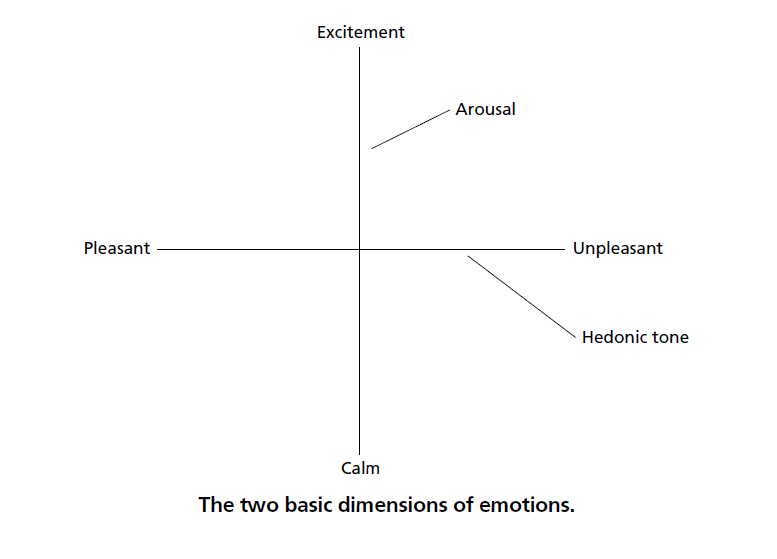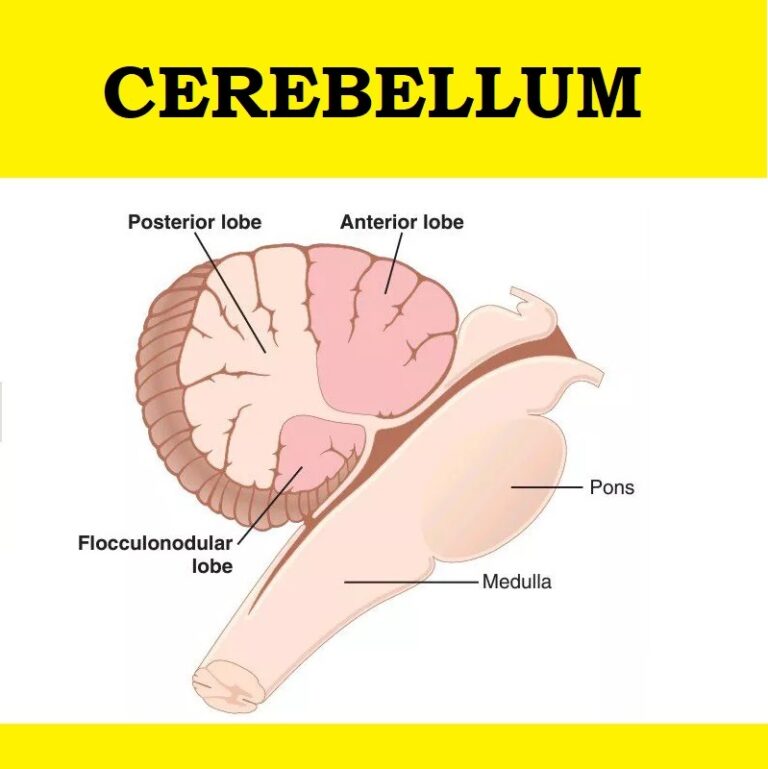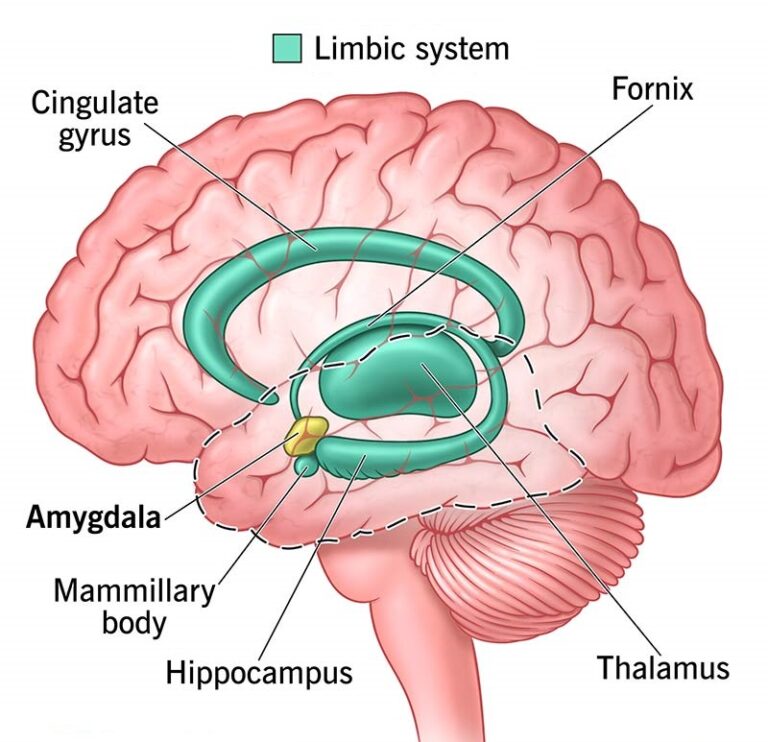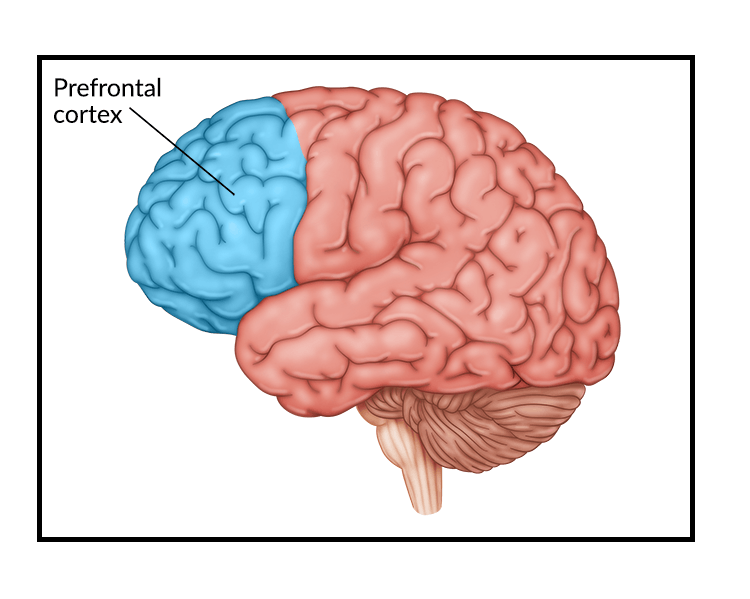
Emotions: Riding Life’s Roller Coaster
PREVIEW QUIZ
The very word emotion contains “motion” in it. (Whenever we act we are, so to speak, in motion.) In this post you will find out how emotions can double as motives and also the way in which emotions add color and dimension to life.
Objectives
After reading this post, you will be able to
• define the concept of emotions;
• identify the two basic psychological dimensions of emotions;
• describe the three aspects of all emotions;
• explain the three basic theories of emotions;
• specify how chronic stress affects general health;
• state the conditions of the four basic kinds of psychological conflict.
What would life be like without emotions?
In some ways life would be better. We would not experience the distress associated with anger, fear, and depression. We would never be in a bad mood. There would be no unhappiness. On the other hand, without emotions there would be no joy, laughter, or excitement. We would never know the pleasure of a good mood. There would be no happiness. Emotions give life much of its dimension and depth. Although emotions can sometimes diminish the quality of existence, they also often enrich life. The ups and downs associated with our emotional states give life something of the quality of a roller-coaster ride. Some people live a wild emotional life characterized by extreme highs and lows. Others lead a more rational emotional life—the highs and lows are not too extreme. But we all ride life’s emotional roller coaster in one way or another. Consequently, emotions merit study and have an important place in psychology.

Emotions: What Are They?
The word emotion is a contraction of two words: exit and motion. The ancient Greeks believed that the smiles and the frowns associated with such states as happiness or sadness indicated that the soul was coming out of the body and revealing itself. It was making an “exit motion.” This became “e-motion” or simply “emotion.” An emotion is, at the physiological level, a disruption in homeostatic baselines. There are changes in heart rate, respiration rate, and blood pressure. These are fluctuations in arousal. At the psychological level, these physiological changes are experienced as either greater excitement or increased calmness. Human beings also experience these changes as either pleasant or unpleasant.
- The word emotion is a contraction of what two words? And
- An emotion is, at the physiological level, a disruption in baselines.
Answers: (a) Exit; motion; (b) homeostatic.
It is evident from the above that there are two basic psychological dimensions to emotions: excitement-calm and pleasant-unpleasant.
The pleasant-unpleasant dimension of emotions is identified as hedonic tone. The concept of hedonism, as presented by the philosopher Aristotle, was a motivational concept. Hedonism is the point of view that we approach stimulus situations that are pleasant and avoid situations that are unpleasant.
The two dimensions of emotions generate four categories of emotions:
(1) excitement-pleasant,
(2) excitement-unpleasant,
(3) calm-pleasant, and
(4) calm-unpleasant.
All of the many words that we use to describe emotions can be readily placed in one of these categories. Words such as happy, joy, and ecstasy belong in category 1. Words such as anger, fear, and rage belong in category 2. Words such as relaxed, blissful, and tranquil belong in category 3. Words such as sad, melancholy, and depressed belong in category 4.
(a) What are the two basic psychological dimensions of emotions?
(b) Proposed by Aristotle, what is the philosophical viewpoint that we approach stimulus situations that are pleasant and avoid situations that are unpleasant?
(c) The two dimensions of emotions generate how many categories of emotions?
Answers: (a) Excitement-calm; pleasant-unpleasant; (b) Hedonism; (c) Four- Excitement-Pleasant, Excitement Unpleasant, Calm Pleasant, Calm Unpleasant

True or False
1. T F The pleasant-unpleasant aspect of emotions is associated with the point
of view, proposed by the philosopher Aristotle, known as hedonism.
2. T F The James-Lange theory proposes that feelings cause our actions.
3. T F Chronic stress appears to have no long-run effect on general health.
4. T F Type A behavior is associated with heart attacks and cardiovascular disease.
5. T F An approach-approach conflict exists when an individual perceives the
same goal in both positive and negative terms.
Answers:1.True, 2. False, 3. False, 4. True, 5. False
There are three aspects to all emotions: (1) cognitive, (2) physiological, and (3) behavioral.
The cognitive aspect of emotions refers to what one is thinking when one feels an emotion. Thoughts such as “What a wonderful day,” “I hate him,” and “I think we’re going to crash” are likely to either induce emotional states or be associated with them.
The physiological aspect of emotions refers to the disruption of homeostatic baselines. As already indicated, emotions are associated with either increased or decreased arousal. Fear is associated with increased arousal. Depression is associated with decreased arousal.
The behavioral aspect of emotions refers to what people do when they feel an emotion, what actions they take. Fear might induce a person to run away, if possible, from the stimulus source that is causing fear. If a person can’t run, he or she might shake and tremble. If the fear is being caused by a threat from a menacing person, one might plead, turn over a purse or wallet, or beg for mercy. On the other hand, an emotion such as depression might induce a particular person to sit in a chair and mope. Another person in response to depression might go on an eating binge.
(a) What one is thinking when one feels an emotion is what aspect of emotions?
(b) Disruption of homeostatic baselines refers to what aspect of emotions?
(c) The actions people take when they feel an emotion refer to what aspect of emotions?
Answers: (a) Cognitive; (b) Physiological; (c) Behavioral.
Theories of Emotion: Explaining the Process
There are three principal theories of emotion that attempt to explain the general emotional process: (1) the James-Lange theory, (2) the Cannon-Bard theory, and (3) the cognitive appraisal theory.
The James-Lange theory was proposed independently by two men, William James in the United States and Carl Lange in Denmark. The theory states that an emotion can be induced by an action. The following example is based on observations made by James. Let’s say that you see a bear in a forest. Common sense tells you that if you run away, the action of running is motivated by fear. On the other hand, according to James, common sense tells only half of the story. It is equally true that running makes you feel fear. At first presentation this does not seem reasonable. On the other hand, reflection suggests that the act of running has the effect of increasing arousal. If you were simply to get up now and run in place for two or three minutes, you would increase your pulse and heart rate; there would be increased arousal. Under the condition of running away from the bear, the act of running intensifies fear by increasing arousal. If there is anything to the James-Lange theory, then one can influence one’s feeling to some extent by willing one’s actions. The familiar advice to walk, not run, when there is a fire in a public place conforms to the James-Lange theory. It is widely recognized that the act of running, by increasing arousal, will cause fear to escalate into panic. In the musical play The King and I, Anna’s young son confesses to her that he is afraid to enter Siam. Anna tells him that one of the tricks she uses to conquer fear is to whistle a happy tune. She says that by acting brave, he might become as brave as he’s making believe he is. Again, the James-Lange theory is at work. An action is inducing a change in an emotional state. Fear is being turned into bravery.
(a) The James-Lange theory states that an emotion can be induced by an ……..
(b) The act of running has the effect of increasing one’s state of ………
Answers: (a) action; (b) arousal.
The Cannon-Bard theory, also known as the thalamic theory, is based on the collaboration of the two researchers Walter B. Cannon and Philip Bard. The Cannon-Bard theory recognizes that the brain’s thalamus is a relay station. When information comes in from the senses and arrives at the thalamus, the information is simultaneously sent up to the cortex and down to the spinal cord. This means that we become conscious of the cause of an emotion at the same time that our body is preparing to deal with it by making changes in physiological arousal. Returning to the bear-in-the-forest example, the Cannon-Bard theory says that you are becoming aroused, and physiologically prepared to run, at the same time that you are able to think, “That’s a bear!” This saves the individual precious time in an emergency.
(a) The Canon-Bard theory is also known as the ………
(b) According to the Cannon-Bard theory, when information comes in from the senses and arrives at the thalamus, the information is sent up to the cortex and down to the spinal cord ……….
Answers: (a) thalamic theory; (b) simultaneously.
Proposed by the researcher Stanley Schachter, the cognitive appraisal theory, also known as the labeling-of-arousal hypothesis, states that a person’s self-labeling of a state of arousal converts that state into a specific emotion. Let’s say that Earl is driving, has taken a wrong turn, and is lost in an unfamiliar area of a big city. His pulse increases, his mouth feels dry, his muscles increase their tension. All of this is involuntary. He is experiencing increased arousal. He asks himself, “What’s going on? Why is my pulse faster?” Let’s say he thinks, “I’m afraid.” By defining his state of arousal in this way, he clearly feels fear. On the other hand, let’s say that he was to take a different cognitive approach. He’s a person who often seeks adventure. He answers the questions posed above by thinking, “I’m getting a kick out of this. It’s a kind of bang to be challenged.” By defining his state of arousal in terms of a more positive outlook, he might be “having fun”— a positive emotional state—instead of experiencing fear.
The hedonic tone, the sense that a state of arousal is pleasant or unpleasant, is often associated with the label that we assign to the state of arousal. It is not necessary to make a distinct choice among the theories in order to determine which one is right and which one is wrong. All three theories have some degree of validity and help us to explain emotional states.
- According to the cognitive appraisal theory, a person’s ……..of a state of arousal converts that state into a specific emotion.
Answer: self-labeling.
Stress and Health: Wear and Tear Takes its Toll
It is widely recognized that increases in arousal tend to be associated with stress. A formal distinction is made between a stressor and stress. A stressor refers to the source, or cause, of stress. The loss of a job, an argument with a spouse, a conflict situation, excessive cold or heat, and a physical threat are examples of stressors. Stress refers to wear and tear on the body. Chronic stress takes a toll. The body loses some of its resilience, its ability to bounce back. Let’s say that you take a small piece of metal and fold it back and forth. A crack appears in the metal after a number of foldings. Each act of folding is a stressor. The crack is the stress.
(a) What term is used to refer to the source, or cause, of stress?
(b) What term is used to refer to wear and tear on the body?
Answers: (a) Stressor; (b) Stress.
The Canadian researcher Hans Selye (1907–1982) did a substantial amount of research on stress. Rats were subjected to such stressors as excessive cold, excessive heat, and high-pitched whistles. Also, the stressors were chronic in nature. They became a constant part of the animal’s environment. Under such conditions, the organism is forced to adapt, and Selye developed a set of observations about the organism’s behavior under such conditions. This set of observations is called the general adaptation syndrome (GAS), a pattern that describes how an organism responds under conditions that induce chronic stress. There are three stages in the general adaptation syndrome: (1) The alarm reaction, (2) the stage of resistance, and (3) the stage of exhaustion.
The alarm reaction is characterized by an increase in arousal and general alertness. The pulse and respiration rates increase and the blood vessels of the striated muscles narrow. The organism prepares itself to deal with a threat. The alarm reaction is the individual’s response to a novel stressor.
(a) What is the name of the pattern that describes how an organism responds under conditions that induce chronic stress?
(b) The reaction is the individual’s response to a novel stressor.
Answers: (a) The general adaptation syndrome; (b) alarm.
The stage of resistance is characterized by reduced agitation and excitement. This stage represents an organism’s response to a stressor that has become chronic. The individual learns to live with the stressor. During the stage of resistance, the organism seems to have adapted to adverse conditions. Learning and reproduction are possible. The stage of exhaustion is associated with illness and death. The death is a premature one. Postmortem examinations of rats subjected to chronic stressors revealed that their adrenal glands were swollen. They had adapted at great physiological cost. During the stage of resistance, the adrenal glands had pumped out excessive amounts of their hormones and had overtaxed themselves.
(a) What stage of the general adaptation syndrome is characterized by reduced agitation and excitement?
(b) What stage of the general adaptation syndrome is characterized by illness and death? Answers: (a) The stage of resistance; (b) The stage of exhaustion.
The importance of the general adaptation syndrome has not been lost on physicians and psychologists. Research suggests that human beings, like Selye’s rats, are also subject to the damaging effects of chronic stressors.
Research on life change units and Type A behavior reveal the important role that stress plays in human illness.
Life change units (LCUs) refers to stressors arising from events in a person’s life that require adaptation. The two researchers who pioneered the general approach are R. H. Rahe and T. H. Holmes. Studying a large group of subjects, they developed a measuring device called the Social Readjustment Rating Scale (SRRS). The scale, based on the perceptions of subjects, assigns weighted values to life changes. The maximum value is 100, and this is assigned to the death of a spouse. Getting married has a value of 50. Loss of a job has a value of 47. Being given a traffic ticket has a value of 11. There are a number of similar items on the scale. If a person collects 150 or more LCUs within a two-year period, there is a high likelihood that he or she will experience a distinct health problem.
(a) What is the name of the measuring device that employs life change units (LCUs)?
(b) Too many LCUs accumulated within a relatively brief time span is associated with what kind of problem?
Answers: (a) The Social Readjustment Rating Scale; (b) A health problem.
The Type A behavior pattern is characterized by hostility and impatience. Research conducted by the cardiologists Meyer Friedman and Ray H. Rosenman strongly supports the hypothesis that individuals who display this pattern are more prone than people in general to heart attacks and cardiovascular disease. The contrasting pattern is called the Type B behavior pattern, and it is characterized by an absence of general hostility and a willingness to allow events to take place at their own rate. As might be expected, individuals who manifest the Type B pattern are less prone to heart disease than individuals who manifest the Type A pattern. The existence of the Type A pattern suggests that behavior can itself be a source of stress. Human beings are capable of self-induced stress, wear and tear on the body generated by their own thoughts, choices, attitudes, and actions. The Roman philosopher Cicero, writing about two thousand years ago, foreshadowed modern research on stress when he said, “To live long it is necessary to live slowly.”
(a) What behavior pattern is characterized by hostility and impatience?
(b) Human beings are capable of stress, wear and tear on the body generated by their own thoughts, attitudes, and actions.
Answers: (a) The Type A behavior pattern; (b) self-induced.
Conflict: Making Difficult Choices
Conflict is an important source of stress. Psychological conflict exists when we are forced to make difficult choices in life. According to the social psychologist Kurt Lewin, there are four basic ways to categorize conflict situations: (1) the approach-approach conflict, (2) the avoidance-avoidance conflict, (3) the approach-avoidance conflict, and (4) the double approach-avoidance conflict.
The approach-approach conflict exists when an individual is presented with two desirable alternatives, but only one alternative can be obtained. Desirable alternatives are termed positive goals. A mild example of an approach approach conflict is selecting a birthday card for a friend or relative. Let’s say that Olympia is trying to pick a birthday card for her husband. She’s narrowed her options down to two cards, but is having a hard time making a final selection. She’s in an approach-approach conflict. An approach-approach conflict might seem to induce relatively low stress. After all, the individual has at least two good choices. But such a conflict can in some cases induce quite a bit of stress. Eighteen-year-old Kirk has been accepted at two leading colleges. They are in different parts of the country. The selection he finally makes will have great long-run significance. He is in an intense approach-approach conflict.
(a) …………..exists when we are forced to make difficult choices in life.
(b) What kind of conflict exists when an individual is presented with two desirable alternatives, but only one alternative can be obtained?
(c) Desirable alternatives are termed……… goals.
Answers: (a) Psychological conflict; (b) An approach-approach conflict; (c) positive.
An avoidance-avoidance conflict exists when the individual wants to either escape from or avoid two undesirable alternatives. Undesirable alternatives are termed negative goals. The central problem with this kind of conflict is that moving away from one negative goal takes one in the direction of the other negative goal. Nineteen-year-old Nancy is in her first year of college. She doesn’t like academic work, is barely passing, and is thinking of dropping out. On the other hand, if she drops out, her parents have indicated they won’t support her. She’ll have to take a low-paying, unskilled job. If she stays in school, she’ll be unhappy. If she takes a low-paying job, she’ll be unhappy. She tells her best friend, “I’m between a rock and a hard place.” Associated with the research of the anthropologist Gregory Bateson, a term sometimes used to identify an avoidance-avoidance conflict is a double bind. A double bind is a no-win situation. Whatever the individual does, there is a sense of failure or loss.
(a) What kind of conflict exists when the individual wants to escape from or avoid two undesirable alternatives?
(b) Undesirable alternatives are termed………… goals.
Answers: (a) An avoidance-avoidance conflict; (b) negative.
An approach-avoidance conflict exists when an individual perceives the same goal in both positive and negative terms. Glen is in love with Margaret and is thinking about marrying her. He sees her as beautiful, warm, and sexually desirable. On the other hand, Glen’s parents are opposed to Margaret. They point out to him that she has a different religious affiliation than that of Glen and his parents. Margaret takes her religion seriously. So do Glen and his parents. The two religions are based on different assumptions. Glen’s parents tell him that they don’t see how he can ever have a happy marriage with Margaret. If Glen and Margaret have children, Margaret will want to raise them in her religious tradition. Glen will want to raise them in his. When Glen is away from Margaret, he thinks about her constantly. He misses her, and often decides that he’ll propose marriage no matter what the consequences. When he’s actually with her, the words associated with the marriage proposal won’t leave his mouth. He gets cold feet at the last minute. One of the characteristics of approach-avoidance conflicts is that the approach tendency tends to gain strength when the positive aspect of the goal seems momentarily out of reach. Conversely, the avoidance tendency tends to gain strength when in the presence of the goal; under these conditions the negative factors tend to loom large. An individual caught in an approach-avoidance conflict often experiences a sustained period of emotional conflict before a final decision is made.
(a) What kind of conflict exists when an individual perceives the same goal in both positive and negative terms?
(b) An approach tendency tends to ………..when the positive aspect of a goal seems momentarily out of reach.
Answers: (a) An approach-avoidance conflict; (b) gain strength.
A double approach-avoidance conflict exists when an individual simultaneously perceives two goals in both positive and negative terms. This conflict is a more complex version of the singular approach-avoidance conflict. Let’s say that Pamela is on a diet. She’s having lunch in a restaurant. She is thinking about ordering either a burger with fries or a salad with broiled chicken. Goal 1, the burger and fries, is the more appealing choice to Pamela from the point of view of taste and general appeal. On the other hand, the negative aspect is that the combination will have too many calories and she’ll be cheating on her diet. Goal 2, the salad with broiled chicken, is the more appealing choice to Pamela from the point of view of caloric content. On the other hand, the negative aspect is that she is weary of salad and wants to have a treat. Pamela’s dilemma presents a fairly mild version of the double approach avoidance conflict. However, such conflicts can be quite intense. Imagine that Glen’s parents introduce him to Naomi. She and her parents are recent arrivals in the neighborhood, and they practice the same religion as Glen and his parents. Naomi is young, pretty, and interested in Glen. He takes her out on a couple of dates. He finds himself attracted to her, but not nearly as attracted as he is to Margaret. By introducing Glen to Naomi, Glen’s parents have thrust him into a double approach-avoidance conflict.
What kind of a conflict exists when an individual simultaneously perceives two goals in both positive and negative terms?
Answer: A double approach-avoidance conflict. SELF-TEST
Self Test- Emotion, Stress, Conflict MCQs
1. The word emotion is a contraction of the two words
a. evaluation and motor
b. exit and motion
c. emission and movement
d. escape and mobile
2. The two basic psychological dimensions of emotion are
a. excitement-calm and low arousal–high arousal
b. extraversion-introversion and pleasant-unpleasant
c. homeostasis-alpha and homeostasis-beta
d. excitement-calm and pleasant-unpleasant
3. Which one of the following is not a basic aspect of emotions?
a. The cognitive aspect
b. The formal-logical aspect
c. The physiological aspect
d. The behavioral aspect
4. The James-Lange theory of emotion states that
a. emotions are illusions
b. all emotions stem from unconscious motives
c. an emotion can be induced by an action
d. emotions are the motives for almost all actions
5. The cognitive appraisal theory of emotion states that
a. the brain’s thalamus is a relay station
b. we become conscious of the cause of an emotion at the same time that our body is preparing to deal with it
c. emotions are metaphysical concepts
d. a person’s self-labeling of a state of arousal converts that state into a specific emotion
6. Which one of the following is not a stage of the general adaptation syndrome (GAS)?
a. The alarm reaction
b. The stage of resistance
c. The stage of frustration
d. The stage of exhaustion
7. The concept of life change units (LCU’s) is associated with which of the following?
a. The Social Readjustment Scale
b. The Wechsler Psychosocial Stressor Inventory
c. The Lewin Cognitive Test
d. The Selye Stress Test
8. The Type A behavior pattern is characterized by
a. hostility and impatience
b. a hedonistic attitude toward life
c. learned optimism
d. an absence of hostility and a willingness to allow events to take place at their own pace
9. In the analysis of psychological conflict, undesirable alternatives are termed
a. positive goals
b. negative goals
c. neutral attributes
d. orienting functions
10. What kind of a conflict exists when the individual wants to either escape from or avoid two undesirable alternatives?
a. An approach-approach conflict
b. An approach-avoidance conflict
c. A double approach-avoidance conflict
d. An avoidance-avoidance conflict 1-b 2-d 3-b 4-c 5-d 6-c 7-a 8-a 9-b 10-d




